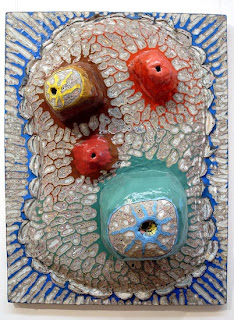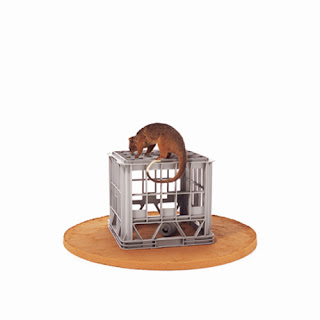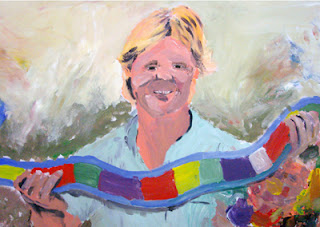Nature seems to be everywhere. Not the real thing of course, which is always inescapably everywhere, but rather the seemingly sudden and complete saturation of the art world with every other exhibition in Sydney taking nature as its metaphor. Nature is on our minds! We have pondered the meaning of this and wondered if it might have some profound connection to the very basis of the human relationship to the natural world and the expression of that relationship through art, and moreover, an expression of the animistic heart of our culture – but then, it’s probably got more to do with so much nature being on the tele at the moment.
Anne Zahalka’s Wild Life at Roslyn Oxley takes the representation of nature found in the antique dioramas of the Mammal Hall at New York’s American Museum of Natural History and updates them to more accurately represent the status of nature in the world today. Into these immaculately constructed dioramas Zahalka has photographically introduced new elements – in a diorama of deer the artist she has added a guy with a rifle [helpfully called Deer Hunter], an alpine scene of mountain goats now has a helicopter and a discarded water bottle [Alpine Scene] – in others tourists meet a lynx, exotic birds meet a lady in kimono and some tourists hassle a brown bear. The photographs have been mounted on the gallery wall that has been painted green and cream to create a faux museum setting and visitors can pop on a pair of headphones to listen to audio – a soundtrack of natural environmental sounds mixed with tour guide chatter and coach air breaks.
Like much of Zahalka’s work, the series has a certain visual appeal but it seems to have little to do with the hammy interventions of the artist. The American Museum’s dioramas are widely acknowledged as masterpieces of an outdated attitude to nature [killing and mounting as an act of ‘preservation’] but which are nonetheless time capsules of no longer extant environments. In Zahalka’s works, the artist uses these images not for what they are but as stand ins for the idea of the ‘museumification’ of nature, a slightly comic rendition of the world in full Victorian splendour. Perhaps if that is what these dioramas were meant to have been about Zahalka’s critique might have some bite but as it stands, she is appealing to the ignorance of people who don’t know anything of the original intention and then congratulating the viewer for being as cynical as the artist. The ecological message of the works is incredibly obvious and frankly, just not very well done. The most successful work is Rising Tide, a diorama of a tropical island with a flock of flamingos flying overhead as the new sea level swamps the island. The best part about it is that you can’t tell what the artist has done, if anything, to the original, which seems to be a sort of indictment of the rest of the series.

Rohan Wealleans, Head, 2004.
Paint, plastic, polystyrene on board, 160x120x150.
Courtesy Roslyn Oxley Gallery.
Rohan Wealleans has the big gallery space at the Ox and although the nature metaphor is somewhat tangential compared to Zahalka, the anthropological aspect is just as strong. Visually reminiscent of Hany Armanious and some of the older works of Karl Weibke, Wealleans is like a grunge lite hippy with maybe too much of a liking for Dances with Wolves – entitled Tatunka the show is a series of huge Native American ‘dream catchers’ painted with startling reds, shocking blues and other inappropriate colours glooped on. From an aesthetic point of view, the works are fantastic, but there’s something so inescapably naff about a non Native American making Native American objects, not to mention that dream catchers are the trinket shop equivalent of rainbow stickers and shaky snows with dolphins inside. Yikes. Wealleans’s Head, a huge head made of paint and polystyrene has an amazing psychedelic intensity and the marbling of the surfaces is vertiginous drop into the whirl of the unconscious, an effect deftly repeated in Disciple of The Pearl, a pear shaped monster that hangs from a purpose built stand a la Dr. Seuss. We’re not sure if Wealleans is actually seeking some equivalence of the unconscious between cultures and if he is, that probably makes it all alright. If he’s not, it’s time to stop taking acid.

Stills Gallery is usually a pretty straight, old school photography gallery. Occasionally they do something a little different – sculpture, video – and the current show of Paul Adair, Daniel Kojta and Pete Volich is very much in this latter category with photography only acting as part – rather than the whole – of the artist’s practice. Volich’s series of works were seen in last year’s Helen Lempriere Scholarship show and we didn’t like them much on first viewing. Second time around we’ve warmed to them considerably, especially since one is about having your polo shirt chewed by a moose. Mounting shirts like commemorative guernseys, Volich’s pieces record events that are far more ordinary. Oh dear… You Won’t Do That Again is the moose-chewed shirt with the unsightly stain, on the torn shirt and a photograph of the moose attached to the bottom of the special frame. The stories behind the other works are a little more obscure, each element adding a clue but with titles like A panel beaten life and love for the sweets, the chain of command had shifted and jnr’s voice was up for it and Reach with you right hand, live with your left. Chin up and bear it for a big life and only piss in a pocket that us reinforced, the works cast Volich as an art world cross between Sufjan Stephens and Dave Eggers.
Kotja’s video installation Alien Presence H – [hand made echo] is a rectangular screen made up of 11 joined frames, each frame a shot of a different location around the world made by the artist and 10 collaborators. The shoot was synchronised and then, in Kotja’s set up, threaded together by lining up the horizon lines of each shot. What you get in effect is a single continuous landscape made up of sectioned landscapes. According to the room sheet “we are bombarded with high velocity information daily. As a result, the possibility of experiencing the present is removed, through the consistent effect of the ‘update’. Knowledge is obsolete before it can be comprehended.” We’re not quite sure how this methodology is meant to reflect this idea, but reading further the artist says that the desert environment is free of ‘updates’ and therefore apparently allowing magic to take place. It’s a hopeful formulation at best since we have always thought that we only ever experience the present, time being a condition of an eternal ‘now’, we must ask how a shot of a desert can alleviate the continual input of living in the present – with or without updates [and precisely what does he mean by that since every second is an update?]. One can at least luxuriate in the slight fuzziness of the logic and the image itself.
Returning to our nature trek, Adair’s works explore “the portrayal of reality in contemporary photography. More specifically, he is interested in exposing a reality that is quite sinister and, in a sense, radically incomplete.” In his Crate, for example, a photograph of a Ring-tailed Possum [not the more common Brush-tailed variety] encounters a milk crate. Poor possie, not only is the milk crate a poor substitute for its preferred environment of the Australian bush, he’s stuffed – literally. Indeed, the whole thing is an artificial set up created by Adair, then shot against a white backdrop, and printed as a huge giclee print. Adair has wandered into similar conceptual territory as Zahalka, but he’s taken it another step by creating more obviously artificial environments that are free of the sentimental obviousness that so badly mars Zahalka’s work. In fact, Adair’s large scale photographs share something of the sensibility of Hayden Fowler, deploying attractive Fahler-esque constructions, as if put together from a kit, with the colour saturation of a Miffy book. Not really sinister, but still creepy as hell.
We went to see two new shows at Chalkhorse, the gallery put together by the ½ Doz. team. Fergus Binns is in the big space with an untitled show and They Guard It So Carefully You’d Think It Was Gold by Kate Mitchell is out the back in the smaller space.

Fregus Binns, Colour and Pattern, 2005.
Binns was in Primavera at the Museum of Contemporary Art last year and he does paintings of icons of Australiana, Steve Irwin, Ayers Rock, cans of VB, barbeque aprons. For this show he has resuscitated some of the Primavera paintings and added some new ones – a painting of a tropical island with a Qantas jet crashed into the ocean,another with the tail of a Qantas jet on fire and burning airliner wreckage littered around Uluru. The one of Steve Irwin holding a snake with stripes of paint on it called Colouration and Pattern from 2005 makes another appearance. The painting ‘quality’ is as bad as we have ever seen and even though some big claims are made in the catalogue for the relevance of making these images, we are profoundly unconvinced. For example:
“…[A] work entitled Diggers (2003), […] presents two faceless Australian men in khaki tropical attire digging a hole, seemingly without purpose. The myth of the Anzac Digger, perhaps our pre-eminent image, is totally undermined. What is left though is not the image of the two diggers, but a question. Why are the Diggers so important to me? This approach is also seen in the number of men dressed in animal suits, koalas and kangaroos etc, who can be found at the pub or just hanging about. What do these animal totems mean? How does a koala come to represent our nation?”
How exactly does this “totally undermine” the Anzac Digger? Brave men and women gave their lives to create the wonderful country that is Australia today and moreover, to guarantee the freedom of someone like Binns to make shit paintings. Like those troublesome Muslim youths, Binns should get down to his local RSL and learn a thing or two about the Anzac tradition. Hell, they might even offer some rudimentary painting classes.
Kate Mitchell’s show is performance art documentation of the artist digging a hole to China, she has compressed it down to 1½ minutes on a video shown on a tiny screen so small you can’t quite make out what she’s doing. In Danger Is My Daily Bread she climbs out on a rope bridge over a river and then cuts through the rope with a knife, and then falls into the water when the bridge collapses. Repeat. A sculpture called You should listen to rocks; they can tell you things (Rocky ) is a fiberglass rock that you’re supposed to put your ear against and hear something. Unfortunately, it wasn’t turned on or it was broken. A pity.

